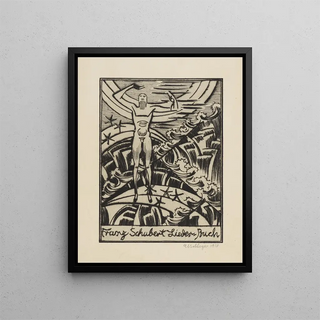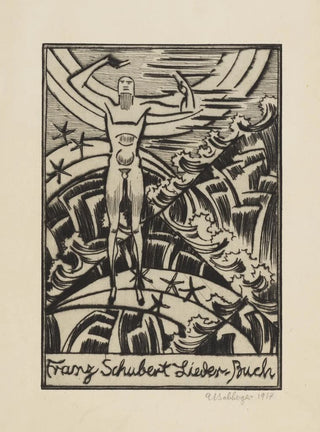Franz Schubert Song Book - August Babberger Art print


View from behind

Frame (optional)
Franz Schubert's "Song Book" art print by August Babberger is much more than a simple illustration. It embodies an era where music and visual art intertwined with rare elegance. This piece, captivating in its composition and color palette, evokes the melancholy and beauty of Schubert's melodies. Every detail, every nuance, seems to resonate with the notes of the composer’s famous lieder, transporting the viewer into a universe where artistic emotion transcends time. Babberger, through his keen eye, invites us to explore the depths of the human soul while paying homage to a master of Romantic music.
Style and uniqueness of the art print
August Babberger's style is distinguished by his ability to capture the very essence of music through visual forms. In this work, he uses soft colors and flowing lines to create an intimate and poetic atmosphere. The depiction of characters, often immersed in contemplative attitudes, reflects an heightened sensitivity, typical of Romantic art. Babberger succeeds in establishing a dialogue between human figures and their environment, allowing viewers to feel the connection between music and painting. This fusion of arts gives birth to an art print that does not merely depict but invites reflection and emotion. The subtle nuances and play of light demonstrate technical mastery that elevates this piece to the rank of an essential art print.
The artist and his influence
August Babberger, although less known than some of his contemporaries, left an indelible mark on the art world. As an artist influenced by the Romantic movement, he skillfully integrated musical themes into his artistic practice, creating a bridge between different forms of expression. His admiration for composers such as Schubert is evident in his works, where he seeks to translate the emotions evoked by music into images. Babberger was also a pioneer in exploring the interaction between art and music, inspiring other artists to follow this path. His legacy lies in this ability to evoke

Matte finish

View from behind

Frame (optional)
Franz Schubert's "Song Book" art print by August Babberger is much more than a simple illustration. It embodies an era where music and visual art intertwined with rare elegance. This piece, captivating in its composition and color palette, evokes the melancholy and beauty of Schubert's melodies. Every detail, every nuance, seems to resonate with the notes of the composer’s famous lieder, transporting the viewer into a universe where artistic emotion transcends time. Babberger, through his keen eye, invites us to explore the depths of the human soul while paying homage to a master of Romantic music.
Style and uniqueness of the art print
August Babberger's style is distinguished by his ability to capture the very essence of music through visual forms. In this work, he uses soft colors and flowing lines to create an intimate and poetic atmosphere. The depiction of characters, often immersed in contemplative attitudes, reflects an heightened sensitivity, typical of Romantic art. Babberger succeeds in establishing a dialogue between human figures and their environment, allowing viewers to feel the connection between music and painting. This fusion of arts gives birth to an art print that does not merely depict but invites reflection and emotion. The subtle nuances and play of light demonstrate technical mastery that elevates this piece to the rank of an essential art print.
The artist and his influence
August Babberger, although less known than some of his contemporaries, left an indelible mark on the art world. As an artist influenced by the Romantic movement, he skillfully integrated musical themes into his artistic practice, creating a bridge between different forms of expression. His admiration for composers such as Schubert is evident in his works, where he seeks to translate the emotions evoked by music into images. Babberger was also a pioneer in exploring the interaction between art and music, inspiring other artists to follow this path. His legacy lies in this ability to evoke






